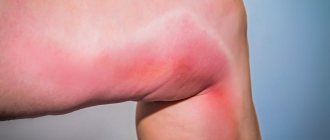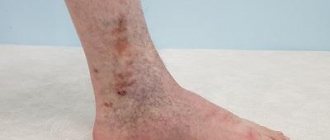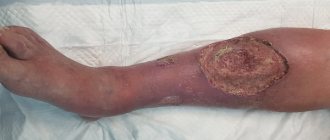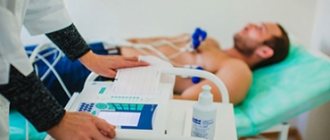With regard to drug treatment, there has long been an opinion among people that “we treat one thing, we cripple another.” And this is true, since most medications have a number of side effects that are detrimental to health. Even seemingly harmless intravenous administration of drugs can lead to inflammation of the veins.
This inflammatory process is called post-injection phlebitis. Let's take a closer look at what pathology is, why the veins become inflamed, and what therapeutic methods are most effective.
Post-injection inflammation of the veins: what is it?
Post-injection, or post-infusion, phlebitis is an inflammation of the venous walls, which is a complication of intravenous injection or infusion.
Among all types of vascular pathology, post-injection phlebitis is recognized as the most common form.
Administration of the drug through a vein causes vasospasm, provoking a narrowing of the venous lumen, as well as the penetration of infection, and leads to inflammation of the vein walls. This process is accompanied by a significant slowdown in blood circulation, deterioration of chemical indicators of blood composition, thinning of the tissues of the vascular walls, the formation of stagnation, and the detection of infectious agents in the plasma. All this increases the risk of blood clots, leading to a serious complication of phlebitis - thrombophlebitis.
Phlebitis caused by infusion is characterized by the following types:
- periphlebitis - inflammation of the subcutaneous tissue at the site of vessel damage;
- panphlebitis - damage to all venous layers;
- endophlebitis is a pathological change in the inner choroid.
Typically, inflammation of the veins after injection is localized on the arms or lower legs, but phlebitis can develop on any part of the body.
Causes of inflammation of the walls of blood vessels
Post-injection phlebitis is formed due to damage to the vein during an intravenous injection or a catheter installed for infusions.
The risk of developing phlebitis depends on many factors. The main ones among them are the following:
- the size (length and diameter) of the needle through which the medicine was administered;
- use of low-quality raw materials for the manufacture of catheters and syringes;
- installation of a device (catheter) for a long time;
- failure to comply with sanitary standards during the procedure;
- ignoring aseptic rules;
- incorrectly calculated dose and high concentration of the administered drug;
- infection (candida, streptococci, staphylococci) due to failure to maintain sterility.
In addition, phlebitis of the vein in the arm can be caused by very rapid administration of a drug (especially solutions of calcium/potassium chloride, glucose, doxycycline hydrochloride) or too concentrated a substance.
After a catheter has been in the vein for a long time, there are frequent cases of infection, which further complicates the inflammation and course of phlebitis.
According to statistics, the development of phlebitis on the arm is most often provoked by self-installation of IVs at home (when removing patients from a drinking binge, ignoring hospital treatment, during urgent emergency care, etc.). Also at risk are people with drug addiction, who very often inject in places that are far from sterile. In such cases, the process of inflammation usually begins with damage to the inner layer of the vessel (endophlebitis) with further progression of the pathology.
How does pathology manifest itself?
Phlebitis after intravenous drip or catheterization of veins manifests itself within 24 hours after the procedure and is accompanied by the following symptoms of venous inflammation:
- thickening due to the accumulation of blood at the injection site and protrusion of the vein outward (appears 2-3 hours after the injection;
- pain when moving a limb;
- stiffening (hardening) of soft tissues, detected upon palpation;
- the appearance of a sharp throbbing pain radiating to the fingers, shoulder, thigh (depending on where the injections were given);
- swelling and swelling of the injection area (appears after a few hours);
- redness of the affected area after 24 hours, followed by the appearance of a burgundy tint and blue discoloration;
- increasing swelling on day 2, swelling of the affected area, including surrounding tissues.
Ignoring the above symptoms of phlebitis leads to the fact that on the 3-4th day the limb stops bending/unbending at the knee/elbow joint, hyperemia and infiltration of the vascular walls develops, and body temperature increases (after some time it can reach 39-40°C).
In the future, the signs of venous inflammation only intensify:
- lymph nodes in the armpits and elbows become inflamed;
- suppuration of the walls of blood vessels forms, affecting nearby arteries.
With such an advanced stage of phlebitis, an operation to excise the pus is prescribed.
In addition, post-infusion phlebitis occurs against a background of general malaise, a noticeable decrease in physical activity, and pronounced pain.
Arm pain
Gout
Arthritis
Rheumatism
Ulcer
35196 March 26
IMPORTANT!
The information in this section cannot be used for self-diagnosis and self-treatment.
In case of pain or other exacerbation of the disease, diagnostic tests should be prescribed only by the attending physician. To make a diagnosis and properly prescribe treatment, you should contact your doctor. Pain in the hand: causes of occurrence, what diseases it occurs with, diagnosis and treatment methods.
Definition
Pain can be accompanied by various pathological processes of the upper extremities - injuries, degenerative and inflammatory lesions, neurological syndromes. Pain in the arm can be one of the symptoms of diseases of the cardiovascular, respiratory and digestive systems of the body.
Types of hand pain
The variety of pain syndromes is determined not only by the complexity of the structure of the upper limbs, but also by the variety of functional loads. By its nature, the pain can be pulling, shooting, aching. It may bother you when there is strain on the arm, or it may occur at night and disturb sleep. In addition, irradiation (return) of pain to the arm is possible due to myocardial infarction, angina pectoris, colic, cholecystitis, and stomach ulcers.
Possible causes of arm pain
Arm pain can be physiological in nature and be caused by muscle fatigue
after heavy or unusual stress.
It occurs due to the accumulation of anaerobic metabolic products (lactate) in muscle tissue and resolves within two to three days.
After significant physical activity exceeding the muscle endurance threshold, delayed pain may occur (1–2 days after physical activity). Experts believe that they are caused by damage to muscle cells, their membranes, and connections between microfibrils. Such pain is usually long-lasting.
Injuries
– bruises, fractures, tendon sprains, muscle tears – are characterized by a sharp onset of pain and its intensity. Bruises and fractures are accompanied by severe pain, swelling, and hemorrhage from small or large vessels.
A sprain occurs when there is a sudden movement in the joint, lifting significant weights, or a fall with emphasis on the arm and is characterized by varying degrees of damage to the connective tissue fibers. This injury is accompanied by severe pain, swelling and limited mobility in the joint. Often, sprains occur in the area of the wrist and elbow joints after heavy loads or monotonous movements repeated many times.
Muscle ruptures and tears occur when overused. In addition to severe pain, there is hemorrhage in the area of injury and the inability to tense the muscle.
One of the largest groups of diseases that causes severe pain in the arm is tunnel syndromes
caused by compression and inflammation of the nerve in a narrow space (tunnel) formed by the muscles, ligaments and bones of the arm.
Additional factors that increase the risk of such inflammation are endocrine diseases (diabetes mellitus, hypothyroidism), impaired joint mobility due to arthritis or rheumatism, tumor formations in the nerve area (neurofibroma, schwannoma) or beyond it (hemangioma, lipoma). As a rule, tunnel syndromes develop during prolonged similar movements (when working at a computer, playing tennis) or injuries. This is facilitated by incorrect posture, scoliosis, and osteochondrosis.
Inflammation of tendons and joint ligaments
also develops with significant physical stress and injury, especially in cases where the tendons are attached to powerful muscles. Stretching and microtrauma at the attachment site are accompanied by aching, aching pain, which can become unbearable during physical activity. Inflammation leads to swelling and limited mobility in the joint. A common pathology of the hand is epicondylitis, in which inflammation affects the junction of the muscle and ligament of the elbow joint. In this case, the pain is localized in the elbow area and accompanies movement in the elbow, hand and fingers.
Joint damage due to arthritis
causes not only pain, but also stiffness of movement. The causes of such damage may be osteoarthritis, gout, etc.
In any case, all signs of inflammation are present: pain, swelling, local increase in temperature, redness of the skin in the projection of the joint, impaired movement in the joint.
Rheumatoid
arthritis
is characterized by damage to first the small and then large joints of the hand, which is accompanied by stiffness of movement in the morning. In addition to increased pain, joint deformation and limited mobility, the disease is also characterized by general manifestations of the disease - fatigue, sweating of the palms and feet, weight loss.
Deposition of uric acid salts (urates) in the joints is the main manifestation of gout
– leads to severe pain. Its intensity is so great that even simply touching the sore joints causes discomfort. The basis of the disease is a metabolic disorder.
With inflammation of the ulnar periarticular synovial bursa - bursitis
– pain occurs in the elbow and is accompanied by swelling of the joint. In addition to severe pain in the arm, which limits movement, local redness of the skin and increased temperature over the joint area may be observed.
Arm pain may be due to anterior scalene syndrome
and be accompanied by muscle spasm and compression of the nerves and vessels of the shoulder girdle. The disease may be based on degenerative changes in the vertebrae (osteochondrosis) of the cervical spine or trauma.
The patient is bothered by pain in the neck and shoulders, which prevents him from raising his arms up and to the sides, taking a deep breath, or tilting his head.
Osteochondrosis of the cervical spine and its complications
(disc protrusion, intervertebral hernia) cause pain in the arm due to pinching of the nerve that innervates it. In this case, not only sharp pain may occur, but also numbness of the hand and impaired sensitivity.
There is another reason that should always be kept in mind when pain in the arm occurs - myocardial infarction
. The patient feels severe pain behind the sternum, which can radiate to the neck, back and left arm. Such pain is not the only sign of this dangerous condition. As a rule, shortness of breath, cold sweat, and difficulty breathing are present.
Diagnosis and examinations for arm pain
To diagnose a condition that may be causing arm pain, it is necessary to consider how acute the pain is and the events that precede its onset. With severe injuries, making a diagnosis is usually not difficult, but to distinguish a bruise from a fracture, radiography is necessary.
Diagnostic methods
If you notice the above symptoms of phlebitis, you should immediately contact a medical facility. A phlebologist treats vascular pathologies.
An experienced specialist, with a thorough visual examination, based on the patient’s complaints and the presence of pronounced signs of post-injection phlebitis, will be able to make a diagnosis.
However, to establish an accurate diagnosis for venous inflammation (phlebitis is often confused with phlegmon of the extremities), additional examinations are necessary:
- general blood and urine analysis;
- blood test for coagulation;
- X-ray and ultrasound of the affected area.
Finding out the full clinical picture of phlebitis will help the specialist prescribe timely and competent treatment, and the patient will avoid severe complications of venous inflammation.
Nodes in the veins of the legs: treatment and its features
Treatment of nodes in the veins of the legs begins only after the patient has undergone a series of laboratory and instrumental examinations, the key of which is ultrasound duplex scanning of the vessels of the lower extremities.
Based on the results obtained, the phlebologist can judge the need for minimally invasive surgical intervention and the degree of its safety for the patient. Vein nodules in the leg can be eliminated under local anesthesia in several ways.
- Laser coagulation of a vessel, which involves introducing a special device into the cavity of a blood vessel and “welding” its walls with thermal radiation. Due to this, it stops filling with blood and is completely excluded from the bloodstream.
- Miniphlebectomy, the essence of which is the complete removal of the affected superficial vessels by removing them from the thickness of the tissue through small punctures.
Methods for treating phlebitis
Treatment of post-injection phlebitis is mainly carried out using conservative therapy, but in difficult cases they resort to more radical methods - surgery.
The choice of treatment method for phlebitis directly depends on how much time has passed since the first signs of venous inflammation were detected. If the patient consults a doctor 1-3 days after the onset of phlebitis, a medicinal method of treatment is used.
To avoid complications of inflammation of the venous walls (phlegmon/thromboembolism), treatment of post-infusion phlebitis is carried out in a hospital setting under the mandatory supervision of a vascular surgeon, especially if an acute period of the disease is detected.
Conservative treatment for phlebitis is prescribed for the purpose of antibacterial treatment and detoxification of the affected area, as well as stopping the source of inflammation, increasing blood circulation and restoring venous walls.
For the treatment of post-injection phlebitis, medications are prescribed:
- non-steroidal anti-inflammatory drugs - Ibuprofen, Butadione, Nimesil, etc.;
- angioprotectors that strengthen blood vessels and increase blood flow - Troxevasin, Heparin;
- indirect anticoagulants to reduce blood viscosity and prevent the formation of blood clots - Aspecard, Warfarin;
- fibrinolytics for dissolving blood clots (in complicated cases) – Urokinase, Streptokinase;
- antibacterial drugs - sulfonamides, tetracyclines, macrolides - to eliminate the risk of blood poisoning.
Treatment of phlebitis with the above-mentioned medications is carried out using tablets, topical preparations (ointments/gels/creams), as well as intramuscular and intravenous injections.
If the inflammation during phlebitis is very severe, then they resort to endolymphatic insertion of a catheter needle to accelerate the therapeutic effect of the drugs.
Gauze bandages with a silver solution, heparin ointment, and semi-alcohol compresses are used as local medications to eliminate phlebitis.
When a patient contacts you early (on days 1-2) for phlebitis, physiotherapeutic procedures are often prescribed. However, when inflammation of the veins intensifies (usually on the 3rd day), hyperthermic procedures are strictly contraindicated. It is allowed to apply cold to the damaged area.
If drug treatment for phlebitis is ineffective, they resort to the surgical method. This occurs when the affected area becomes even more inflamed, suppuration begins and blood clots form. The operation for phlebitis of the veins in the arms is performed in a hospital under local anesthesia and is reduced to removing the formed abscesses. The recovery period after such manipulation lasts about 2-3 weeks.
Doctors recommend wrapping the limb with an elastic bandage on the second day after surgery, as well as ensuring rest and placing the affected arm (leg) on an elevated surface.
Please note that if a surgical incision is made, physiotherapeutic procedures for the treatment of inflammation of the veins in the arms are prohibited.
Ignoring the treatment of post-infusion phlebitis or self-medication is unacceptable, since a complication of the inflammation process is possible, threatening the death of the patient.
Thrombophlebitis of the superficial veins: diagnosis and treatment
D
This type of pathology is a very common disease of the venous system, which is encountered by doctors of any specialty.
Currently, terms such as phlebothrombosis and varicothrombophlebitis are also often used in medical practice. All of them are legal to use, but the following points should be taken into account. Phlebothrombosis is considered as an acute obstruction of a vein as a result of hypercoagulation, which is the leading mechanism. But after 5–10 days, the resulting thrombus causes reactive inflammation of the tissues surrounding the vein with the development of phlebitis, that is, phlebothrombrosis transforms into thrombophlebitis
.
The term “varicothrombophlebitis” clearly indicates, in fact, the initial cause of thrombosis that occurs against the background of varicose veins that the patient already had.
The pathology of the venous system listed above in the overwhelming majority of clinical cases occurs in the large saphenous vein system and much less often in the small saphenous vein system.
Thrombophlebitis of the veins in the upper extremities is extremely rare, and the main provoking factors for their occurrence are multiple punctures for administering medications or prolonged placement of a catheter in a superficial vein.
Particular attention should be paid to patients with spontaneously occurring thrombi on the upper and lower extremities, not associated with iatrogenic effects. In such cases, the phenomenon of thrombophlebitis can be suspected as a manifestation of a paraneoplastic reaction caused by the presence of an oncological pathology in the patient, requiring an in-depth multifaceted examination.
Thrombosis in the superficial venous system is provoked by the same factors that cause thrombosis of the deep venous system of the lower extremities. These include: age over 40 years, the presence of varicose veins, cancer, severe disorders of the cardiovascular system (cardiac decompensation, occlusion of the main arteries), physical inactivity after major operations, hemiparesis, hemiplegia, obesity, dehydration, common infections and sepsis, pregnancy and childbirth, taking oral contraceptives, limb trauma and surgical interventions in the area of venous trunks.
Thrombophlebitis can develop in any part of the superficial venous system
, with the most common localization on the lower leg in the upper or middle third, as well as the lower third of the thigh. The overwhelming number of cases of thrombophlebitis (up to 95–97%) were noted in the basin of the great saphenous vein (Kabirov A.V. et al., Kletskin A.E. et al., 2003).
The further development of thrombophlebitis can actually occur in two ways:
1. Relatively favorable course of the disease
, against the background of the treatment, the process stabilizes, thrombus formation stops, inflammation subsides and the process of organizing a blood clot begins, followed by recanalization of the corresponding part of the venous system. But this cannot be considered a cure, because... Damage to the initially altered valve apparatus always occurs, which further aggravates the clinical picture of chronic venous insufficiency.
Clinical cases are also possible when a fibrotic thrombus tightly obliterates the vein and its recanalization becomes impossible.
2. The most unfavorable and dangerous option
in terms of the development of local complications - ascending thrombosis along the great saphenous vein to the fossa ovale or the transition of the thrombotic process through the communicating veins to the deep venous system of the leg and thigh.
The main danger of the course of the disease according to the second option is the threat of developing a complication such as pulmonary embolism (PE), the source of which can be a floating thrombus from the system of the small or great saphenous vein, as well as secondary thrombosis of the deep veins of the lower extremities.
It is quite difficult to judge the frequency of thrombophlebitis among the population, but if we take as a basis the fact that among patients hospitalized in surgical departments with this pathology, more than 50% had varicose veins, then taking into account the millions of patients with this pathology in the country, this figure looks very impressive and The problem is acquiring great medical and social significance.
The age of patients ranges from 17 to 86 years and even older, and the average age is 40–46 years, that is, the working population.
Considering the fact that with thrombophlebitis of the superficial veins, the patient’s general condition and well-being, as a rule, do not suffer and remain quite satisfactory, this creates for the patient and his relatives the illusion of relative well-being and the possibility of various methods of self-medication.
As a result, such behavior of the patient leads to late referral for qualified medical care, and often the surgeon is faced with complicated forms of this “simple” pathology, when high ascending thrombophlebitis or deep vein thrombosis of the limb occurs.
Clinical picture
The clinical picture of the disease is quite typical in the form of local pain in the projection of the saphenous veins at the level of the leg and thigh
with the involvement of the tissues surrounding the vein in the process, up to the development of sharp hyperemia of this zone, the presence of compactions not only of the vein, but also of the subcutaneous tissue. The longer the zone of thrombosis, the more pronounced the pain in the limb, which forces the patient to limit its movement. Hyperthermic reactions in the form of chills and an increase in temperature to 38–39°C are possible.
Quite often, even a banal acute respiratory disease becomes a provoking moment for the occurrence of thrombophlebitis, especially in patients with varicose veins of the lower extremities.
The examination is always carried out from both sides - from the foot to the groin area. Attention is drawn to the presence or absence of pathology of the venous system, the nature of changes in skin color, local hyperemia and hyperthermia, and swelling of the limb. Severe hyperemia is typical for the first days of the disease; it gradually decreases by the end of the first week.
When thrombophlebitis is localized in the small saphenous vein, local manifestations are less pronounced than when the trunk of the great saphenous vein is affected, which is due to the peculiarities of the anatomy. The superficial layer of the shin's own fascia, covering the vein, prevents the transition of the inflammatory process to the surrounding tissues. The most important point is to find out the timing of the onset of the first symptoms of the disease, the speed of their increase, and whether the patient has attempted to influence the process with medication.
So, according to A.S. Kotelnikova et al. (2003), the growth of a blood clot in the great saphenous vein system is up to 15 cm per day. It is important to remember that in almost a third of patients with ascending thrombosis of the great saphenous vein, its true upper limit is located 15–20 cm above the level determined by clinical signs (V.S. Savelyev, 2001), that is, this fact should every surgeon should take into account when advising a patient with thrombophlebitis of a vein at the hip level, so that there is no undue delay in the operation aimed at preventing pulmonary embolism.
It should also be considered inappropriate to administer local anesthetics and anti-inflammatory drugs to the area of the thrombosed vein on the thigh, since, while relieving pain, this does not prevent the growth of the thrombus in the proximal direction. Clinically, this situation becomes difficult to control, and duplex scanning can really only be used in very large medical institutions.
Differential diagnosis
should be carried out with erysipelas, lymphangitis, dermatitis of various etiologies, erythema nodosum.
Instrumental and laboratory diagnostics
For a very long time, the diagnosis of thrombophlebitis of the superficial veins was made by a doctor based only on the clinical symptoms of the disease, since there were virtually no non-invasive methods for characterizing venous blood flow. The introduction of ultrasound diagnostic methods into practice has opened a new stage in the study of this common pathology. But the clinician must know that among ultrasound methods for diagnosing venous thrombosis, the decisive role is given to duplex scanning, since only with its help can one determine a clear boundary of thrombosis, the degree of organization of the thrombus, the patency of the deep veins, the condition of the communicants and the valve apparatus of the venous system. Unfortunately, the high cost of this equipment still sharply limits its practical use in outpatient and inpatient settings.
This study is indicated primarily for patients with suspected embologenic thrombosis, that is, when there is a transition of a thrombus from the superficial to the deep venous system through the sapheno-femoral or sapheno-popliteal anastomosis.
The study can be carried out in several projections, which significantly increases its diagnostic value.
Phlebographic examination
The indications for it have been sharply narrowed. The need to perform it arises only in the event of a thrombus spreading from the great saphenous vein to the common femoral and iliac vein. Moreover, this study is carried out only in cases where the results of duplex scanning are doubtful and their interpretation is difficult.
Laboratory diagnostic methods
In a routine clinical blood test, attention is paid to the level of leukocytosis and the level of ESR.
It is advisable to study C-reactive protein, coagulogram, thrombelastogram, prothrombin index level and other indicators characterizing the state of the coagulation system. But the scope of these studies is sometimes limited by the capabilities of the laboratory service of a medical institution.
Treatment
One of the important points that determine the outcome of the disease and even the fate of the patient is the choice of tactics for the optimal treatment option for the patient.
If thrombophlebitis is localized at the level of the lower leg, the patient can undergo treatment on an outpatient basis, under the constant supervision of a surgeon. In these conditions, it is necessary to explain to the patient and his relatives that if signs of thrombosis spreading to the hip level appear, the patient may need to be hospitalized in a surgical hospital. Delay in hospitalization is fraught with the development of complications, including the occurrence of pulmonary embolism.
In cases where thrombophlebitis at the level of the leg, treated for 10–14 days, does not respond to regression, the question of hospitalization and more intensive treatment of the disease should also be raised.
One of the main issues in the treatment of patients with thrombophlebitis of the superficial veins is the discussion of the need for the patient to comply with strict bed rest
.
It is now a recognized fact that strict bed rest is indicated only for patients who already had clinical signs of pulmonary embolism or there are clear clinical data and the results of instrumental studies indicate the embologenic nature of thrombosis.
The patient's physical activity should be limited only to severe physical activity (running, lifting weights, performing any work that requires significant muscle tension in the limbs and abdominals).
General principles of treatment of superficial vein thrombophlebitis
These principles are truly general for both conservative and surgical treatment of this pathology. The main objectives of treatment
these patients are:
- Act as quickly as possible on the source of thrombosis and inflammation to prevent its further spread.
- Try to prevent the transition of the thrombotic process to the deep venous system, which significantly increases the risk of developing pulmonary embolism.
- Treatment should be a reliable method of preventing recurrent thrombosis of the venous system.
- The treatment method should not be strictly fixed, since it is determined primarily by the nature of the changes occurring in the limb in one direction or another. That is, it is quite logical to switch or complement one treatment method with another.
Of course, conservative treatment
indicated for the absolute majority of patients with “low” superficial thrombophlebitis of the saphenous veins.
Once again, it should be emphasized that reasonable physical activity of the patient improves the function of the muscle pump, which is the main determinant in ensuring venous outflow in the inferior vena cava system.
The use of external compression (elastic bandage, stockings, tights) in the acute phase of inflammation can cause some discomfort, so this issue should be resolved strictly individually.
The issue of using antibiotics in this category of patients is quite controversial. The doctor must remember the possible complications of this therapy (allergic reactions, intolerance, provocation of blood hypercoagulation). Also, the question of the advisability of using anticoagulants (especially direct action) in this group of patients is far from clear.
The doctor must remember that the use of heparin after 3-5 days can cause thrombocytopenia in the patient, and a decrease in the platelet count by more than 30% requires discontinuation of heparin therapy. That is, difficulties arise in controlling hemostasis, especially in an outpatient setting. Therefore, it is more appropriate to use low molecular weight heparins (dalteparin, nadroparin, enoxaparin), since they extremely rarely cause the development of thrombocytopenia and do not require such careful monitoring of the coagulation system. The positive thing is that these drugs can be administered to the patient once a day. A course of treatment requires 10 injections, and then the patient is transferred to indirect anticoagulants.
In recent years, ointment forms of heparin (Lioton-gel, Hepatrombin) have appeared for the treatment of these patients. Their main advantage is fairly high doses of heparin, which are delivered directly to the site of thrombosis and inflammation.
Of particular note is the targeted effect on the zone of thrombophlebitic changes of the drug Gepatrombin
(“Hemofarm” – Yugoslavia), produced in the form of ointment and gel.
Unlike Lyoton, it contains 2 times less heparin, but additional components - allantoin and dexpanthenol, which are part of the ointment and gel "Gepatrombin", as well as pine essential oils, which are part of the gel, have a pronounced anti-inflammatory effect, reduce skin itching and local pain in the area of thrombophlebitis. That is, they help relieve the main symptoms of thrombophlebitis. The drug Gepatrombin has a strong antithrombotic effect.
It is used topically by applying a layer of ointment to the affected areas 1-3 times a day. If there is an ulcerative surface, the ointment is applied in the form of a ring up to 4 cm wide around the perimeter of the ulcer. The good tolerability of the drug and the versatility of its effect on the pathological focus puts this medicine at the forefront in the treatment of patients with thrombophlebitis both on an outpatient basis and during treatment in hospitals. Hepatrombin can be used in a complex of conservative treatment or as a means aimed at relieving inflammation of the venous nodes after the Troyanov-Trendelenburg operation, as a method of preparation for the second stage of the operation.
The complex of conservative treatment of patients should include non-steroidal anti-inflammatory drugs
, which also have an analgesic effect. But the clinician must remember to exercise extreme caution when prescribing these drugs to patients with diseases of the gastrointestinal tract (gastritis, peptic ulcer) and kidneys.
Phlebotonics, already well known to doctors and patients, have proven themselves well in the treatment of this pathology.
(rutoside, troxerutin, diosmin, gingko biloba and others) and
disaggregants
(acetylsalicylic acid, pentoxifylline). In severe cases with extensive phlebitis, intravenous transfusions of rheopolyglucin 400–800 ml IV for 3 to 7 days are indicated, taking into account the cardiac status of the patient due to the danger of hypervolemia and the threat of developing pulmonary edema.
Systemic enzyme therapy has limited use in practice due to the high cost of the drug and a very long course of treatment (from 3 to 6 months).
Surgery
The main indication for surgical treatment of thrombophlebitis, as previously indicated, is the growth of a blood clot along the great saphenous vein above the middle third of the thigh or the presence of a blood clot in the lumen of the common femoral or external iliac vein, which is confirmed by phlebography or duplex scanning. Fortunately, the latter complication does not occur so often, in only 5% of patients with ascending thrombophlebitis (I.I. Zatevakhin et al., 2003). Although individual reports indicate a significant frequency of this complication, reaching even 17% in this group of patients (N.G. Khorev et al., 2003).
Methods of anesthesia - different options are possible: local, conduction, epidural anesthesia, intravenous, intubation anesthesia.
The position of the patient on the operating table is of certain importance - the foot end of the table should be lowered.
The generally accepted operation for ascending thrombophlebitis of the great saphenous vein is the Troyanov–Trendelenburg operation.
.
The surgical approach used by most surgeons is quite typical - an oblique incision below the inguinal fold according to Chervyakov or the inguinal fold itself. But at the same time, it is important to take into account the main clinical point: if there are instrumental data or clinical signs of a thrombus moving into the lumen of the common femoral vein, then it is more advisable to use a vertical incision that provides control over the thrombosed great saphenous vein and the trunk of the common femoral vein, when it is sometimes necessary to clamp it moment of thrombectomy.
Some technical features of the operation:
1. Mandatory isolation, intersection and ligation of the trunk of the great saphenous vein in the area of its mouth.
2. When opening the lumen of the great saphenous vein and detecting a thrombus in it that extends beyond the level of the ostial valve, the patient must hold his breath at the height of inspiration during surgery under local anesthesia (or this is done by an anesthesiologist for other types of anesthesia).
3. If the thrombus “does not form on its own,” then a balloon catheter is carefully inserted through the saphenofemoral anastomosis at the height of inspiration and thrombectomy is performed. Retrograde blood flow from the iliac vein and antegrade blood flow from the superficial femoral vein are checked.
4. The stump of the great saphenous vein must be sutured and ligated; it must be short, since a stump that is too long is an “incubator” for the occurrence of thrombosis, which creates a threat of the development of pulmonary embolism.
In order to discuss options for this routine operation, it should be noted that during the Troyanov-Trendelenburg operation, some surgeons suggest performing thrombectomy from the great saphenous vein and then injecting a sclerosant into it. The expediency of such manipulation is questionable.
The second stage of the operation - removal of thrombosed varicose nodes and trunks is carried out according to individual indications in a period of 5-6 days to 2-3 months as local inflammation is relieved, in order to avoid suppuration of wounds in the postoperative period, especially with trophic skin disorders.
When performing the second stage of the operation, the surgeon must ligate the perforating veins after preliminary thrombectomy, which improves the healing process.
All conglomerates of varicose nodes must be removed to avoid the further development of severe trophic disorders.
A very wide range of general surgeons and angiosurgeons are involved in the surgical treatment of this group of patients.
The apparent simplicity of treatment sometimes leads to tactical and technical errors. Therefore, this topic is almost constantly present at scientific conferences. Literature:
1. Zatevakhin I.I. with co-authors. “Angiology and Vascular Surgery” No. 3 (supplement) 2003, pp. 111–113.
2. Kabirov A.V. with co-authors. “Angiology and Vascular Surgery” No. 3 supplement 2003, pp. 127–128.
3. Kletskin A.E. with co-authors. “Angiology and Vascular Surgery” No. 3 (supplement) 2003, pp. 161–162.
4. Kotelnikov A.S. with co-authors. “Angiology and Vascular Surgery” No. 3 (supplement) 2003, pp. 168–169.
5. Revskoy A.K. “Acute thrombophlebitis of the lower extremities” M. Medicine 1976
6. Savelyev V.S. "Phlebology" 2001
7. Khorev N.G. “Angiology and Vascular Surgery” No. 3 (supplement) 2003, pp. 332–334.
Traditional methods of treatment
To speed up the recovery process for post-injection phlebitis, alternative medicine is often used - ointments and compresses based on components of plant origin. However, treatment of inflammation of the vascular walls can be carried out only after consultation with a doctor and testing for the absence of an allergic reaction.
We suggest using the most effective recipes that relieve venous inflammation:
- Honey compress. Lubricate the area of inflammation with liquid honey and wrap it with natural fabric (linen, chintz).
- Applying cabbage leaf. Crumple a cabbage leaf thoroughly washed and scalded with boiling water, spread with honey and apply to the site of inflammation. Secure with a bandage.
- A decoction of beet tops relieves inflammation well. Pour 50 g of dried red beet leaf into 1 liter of boiling water. Let it brew for an hour. Take 150 ml of infusion in the morning on an empty stomach.
- A decoction of currant or rowan leaves. Take the raw material brewed using the above method for venous inflammation 2-3 times a day, 100 ml.
Please note that traditional medicine for inflammation of the vascular walls after injection are additional preventive measures and cannot replace the main treatment of phlebitis with medications.
Preventive measures
Not a single patient is immune from the post-injection form of phlebitis. Therefore, every person must take responsibility for their health and lead a healthy lifestyle.
What to do to avoid the formation of phlebitis. To prevent vascular inflammation, doctors recommend the following measures:
- regular walks in the fresh air at any time of the year;
- rejection of bad habits;
- daily physical activity (jogging, gymnastic elements, aerobic and cardio exercise);
- adherence to the principles of proper nutrition;
- exclusion from the diet of fatty, salty, spicy foods;
- adherence to a daily routine (full rest and sleep are required).
If you are undergoing treatment using intravenous injections and droppers, lubricate the needle insertion site with venotonics (Venoruton, Troxevasin, etc.) to prevent inflammation of the vascular walls.
Remember that phlebitis does not forgive a frivolous attitude. Therefore, if you suspect venous inflammation, immediately seek help from specialists. Timely measures taken to eliminate phlebitis guarantee complete recovery.
Rehabilitation and possible contraindications
After the operation, the patient is recommended to:
- wear compression stockings,
- try to walk a lot,
- avoid strenuous physical activity.
However, in some situations, seals in the veins of the legs are not recommended to be removed using the proposed methods, as this is fraught with great risk for the patient. This is about:
- obesity,
- serious pathologies of the cardiovascular system,
- thrombophilia,
- inflammatory processes of the skin in the area of affected vessels.
A knot in a vein in the leg is not just a cosmetic problem; it must be fought radically and decisively. The phlebologists at the First Family Clinic of St. Petersburg will help you with this. Make an appointment, we are waiting for you at Kolomyazhsky Prospekt, 36/2.










